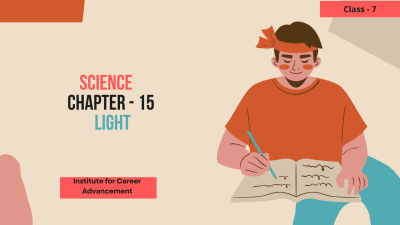Course description
Here’s a brief overview of what is usually included in the curriculum:
Introduction to Light:
Definition of light, its sources, and its importance in everyday life.
Understanding that light travels in straight lines.
Reflection:
Laws of reflection: angle of incidence equals angle of reflection.
Types of reflection: regular (specular) and diffuse.
Refraction:
Definition and examples of refraction.
Snell's Law: relationship between the angles of incidence and refraction.
Refractive index and its significance.
Lenses:
Concave and convex lenses: their shapes and characteristics.
Focusing of light by lenses.
Applications of lenses in daily life (e.g., eyeglasses, cameras, microscopes).
Mirrors:
Concave and convex mirrors: differences in shape and applications.
Image formation by mirrors (real and virtual images).
Optical Instruments:
Microscopes and telescopes: their construction and working principles.
Understanding magnification and resolving power.
Dispersion of Light:
Prisms and their role in dispersing white light into its constituent colors.
Formation of rainbow and its explanation.
Light and Color:
Perception of color and its relationship to wavelength.
Primary colors of light and pigments.
Light and Shadows:
Formation of shadows and their characteristics.
Eclipse phenomena (solar and lunar) and their explanations.
Optical Phenomena:
Polarization of light and its applications.
Interference and diffraction: basic concepts and examples.
পাঠ্যক্রমে সাধারণত কী অন্তর্ভুক্ত করা হয় তার একটি সংক্ষিপ্ত বিবরণ এখানে দেওয়া হল:
আলোর ভূমিকা:
আলোর সংজ্ঞা, এর উৎস এবং দৈনন্দিন জীবনে এর গুরুত্ব।
বুঝতে হবে যে আলো সরলরেখায় ভ্রমণ করে।
প্রতিফলন:
প্রতিফলনের নিয়ম: আপতন কোণ প্রতিফলনের কোণের সমান।
প্রতিফলনের ধরন: নিয়মিত (স্পেকুলার) এবং ছড়িয়ে পড়া।
প্রতিসরণ:
সংজ্ঞা এবং প্রতিসরণ উদাহরণ.
স্নেলের আইন: আপতন কোণ এবং প্রতিসরণের মধ্যে সম্পর্ক।
প্রতিসরণ সূচক এবং এর তাৎপর্য।
লেন্স:
অবতল এবং উত্তল লেন্স: তাদের আকার এবং বৈশিষ্ট্য।
লেন্স দ্বারা আলো ফোকাস করা.
দৈনন্দিন জীবনে লেন্সের প্রয়োগ (যেমন, চশমা, ক্যামেরা, মাইক্রোস্কোপ)।
আয়না:
অবতল এবং উত্তল আয়না: আকৃতি এবং প্রয়োগের পার্থক্য।
আয়না দ্বারা চিত্র গঠন (বাস্তব এবং ভার্চুয়াল ছবি)।
অপটিক্যাল যন্ত্র:
মাইক্রোস্কোপ এবং টেলিস্কোপ: তাদের নির্মাণ এবং কাজের নীতি।
বিবর্ধন এবং সমাধান করার ক্ষমতা বোঝা।
আলোর বিচ্ছুরণ:
প্রিজম এবং সাদা আলোকে এর উপাদান রঙে ছড়িয়ে দিতে তাদের ভূমিকা।
রংধনু গঠন এবং এর ব্যাখ্যা।
আলো এবং রঙ:
রঙের উপলব্ধি এবং তরঙ্গদৈর্ঘ্যের সাথে এর সম্পর্ক।
আলো এবং রঙ্গক প্রাথমিক রং.
আলো এবং ছায়া:
ছায়ার গঠন এবং তাদের বৈশিষ্ট্য।
গ্রহন ঘটনা (সৌর এবং চন্দ্র) এবং তাদের ব্যাখ্যা।
অপটিক্যাল ঘটনা:
আলোর মেরুকরণ এবং এর প্রয়োগ।
হস্তক্ষেপ এবং বিভাজন: মৌলিক ধারণা এবং উদাহরণ।



















